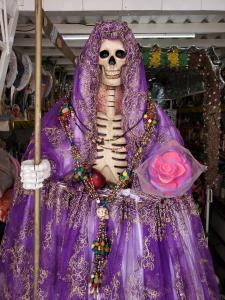
Most street shrines in Mexico are dedicated to a single Catholic or folk saint. Makeshift public altars to the Virgin of Guadalupe, Saint Jude, and Santa Muerte figure among the most popular ones from Tijuana to Tapachula. Having seen hundreds of street shrines in my four decades of doing research, living in, and visiting Mexico, I can’t help but focus on one of the most unusual ones which unites the three most popular “thug saints” in one shrine. In the rough-and-tumble Doctores district of Mexico City, known for shops that sell stolen auto parts, a large concrete and glass sidewalk niche houses life-size effigies of Santa Muerte, Jesus Malverde, and Saint Jude Thaddeus. Erected some two decades ago as a Santa Muerte shrine, the immaculately maintained sacred space incorporated the Sinaloan folk saint Jesus Malverde several years later and Patron of Lost Causes, Saint Jude, less than a year ago.

All three saints have widespread popular appeal in the country that is home to the second largest Catholic population on the planet and are implored for miracles of health, wealth, love, and protection. However, all three have reputations for being especially popular among criminal elements and as such are collectively know as thug saints (los santitos de los mañosos). Of the three, it’s Jesus Malverde who is best known as a thug saint or more specifically, as the original narco-saint who is especially popular with the drug syndicate of his home state, the Sinaloa Cartel of the infamous incarcerated capo, El Chapo Guzman whose legal team brought a statuette of the mustachioed macho folk saint to the New York courtroom where the flamboyant drug lord was being tried. Many of the popular images of Malverde, whose surname translates as “Badgreen,” depict him with marihuana leaves. However, in an effort to show he’s more than just a narco-saint, Malverde is also frequently portrayed as a devotee of the Virgin of Guadalupe, appearing alongside with the Queen of Mexico in many memes and gifs.

Like her fellow folk saint from Sinaloa, Santa Muerte has a reputation for being a narco-saint popular among cartel members who ask her for favors of protection from and vengeance against both rival narcos and law enforcement. Even though it was the news that the Mexican army had been tasked with razing some 40 Santa Muerte shrines on the border with Texas and California in March of 2009 that served as the catalyst for my initial interest in the folk saint of death, I have spent 13 years trying to demonstrate that the Bony Lady (one of her popular monikers) is so much more than just a narco-saint. Supernatural healer, love sorceress, and attorney for the accused stand out as a few of her most important roles. And while she is a multitasking miracle-worker worshiped by the majority of Santa Muertistas who aren’t drug traffickers, her reputation as a narco-saint continues to dominate media and cinematic portrayals of her.

That the two most popular thug saints watch over a busy street in a barrio known for stolen car parts is of little surprise, but the presence of Mexico’s most popular Catholic saint, Jude, should perplex many. One of the newest Catholic saints on the Mexican religious landscape, the Patron of Lost Causes only began to attract a widespread following in the 1980s when Colombian narcos introduced him to their Mexican counterparts. After four decades of meteoric growth, Saint Jude’s appeal is far wider and broader than that of the two folk saints in terms of social class, but he still attracts sufficient numbers of criminals and marginalized youth to earn the reputation as thug saint.

He has become so popular that his national shrine in Mexico City, San Hipolito Church, and several other regional ones celebrate his feast day each 28th day of the month. I know of no other Catholic saint whose feast is celebrated on a monthly basis. Reinforcing his reputation as a thug saint, scores of his marginalized young devotees huff glue and paint thinner on the streets adjacent to San Hipolito during his monthly fiesta. Moreover, the popular belief that when San Juditas, as he’s affectionately known, appears with his staff in his left hand signals his openness to left-handed petitions, those that are beyond the pale of Christian morality, such as revenge, solidifies his reputation as a Santito de los Mañosos.

That two of the three giants of the Mexican religious landscape, Santa Muerte and Saint Jude, serve as thug saints speaks volumes about the strong demand for quick miracles that don’t necessarily adhere to Christian ethics. In a Mexico plagued by horrific narco-violence in which some 300,000 have been murdered since 2006 there are scores of citizens seeking supernatural justice and/or vengeance for family members and friends who have been killed in the bloody battles over marihuana, heroin, and fetanyl, which is mostly destined for US and European markets.

















